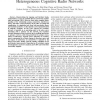Free Online Productivity Tools
i2Speak
i2Symbol
i2OCR
iTex2Img
iWeb2Print
iWeb2Shot
i2Type
iPdf2Split
iPdf2Merge
i2Bopomofo
i2Arabic
i2Style
i2Image
i2PDF
iLatex2Rtf
Sci2ools
GLOBECOM
2010
IEEE
2010
IEEE
Phase Transition Diagram for Underlay Heterogeneous Cognitive Radio Networks
Abstract--Characterizing the topology and therefore fundamental limits is a must to establish effective end-to-end cognitive radio networking (CRN). However, there lacks complete understanding of the relationship among connectivity, interference, latency and other system parameters of the CRN. To clarify this complication, by employing tools from both percolation theory and stochastic geometry, we thus provide a novel parametrization of underlay secondary ad hoc CRN wherein the secondary network is regarded as an operating point in the phase space. Coexisting with a primary ad hoc network, the secondary network undergoes a phase transition due to avoiding interference to primary receivers, while being interfered by primary transmitters. Furthermore, transmit power allocation of secondary users is represented by a Pareto contour in the phase space, and the impact of interference on connectivity is captured by the latency-to-percolate. Finally, with the cognitive capability of CR, perfor...
| Added | 02 Mar 2011 |
| Updated | 02 Mar 2011 |
| Type | Journal |
| Year | 2010 |
| Where | GLOBECOM |
| Authors | Weng-Chon Ao, Shin-Ming Cheng, Kwang-Cheng Chen |
Comments (0)

